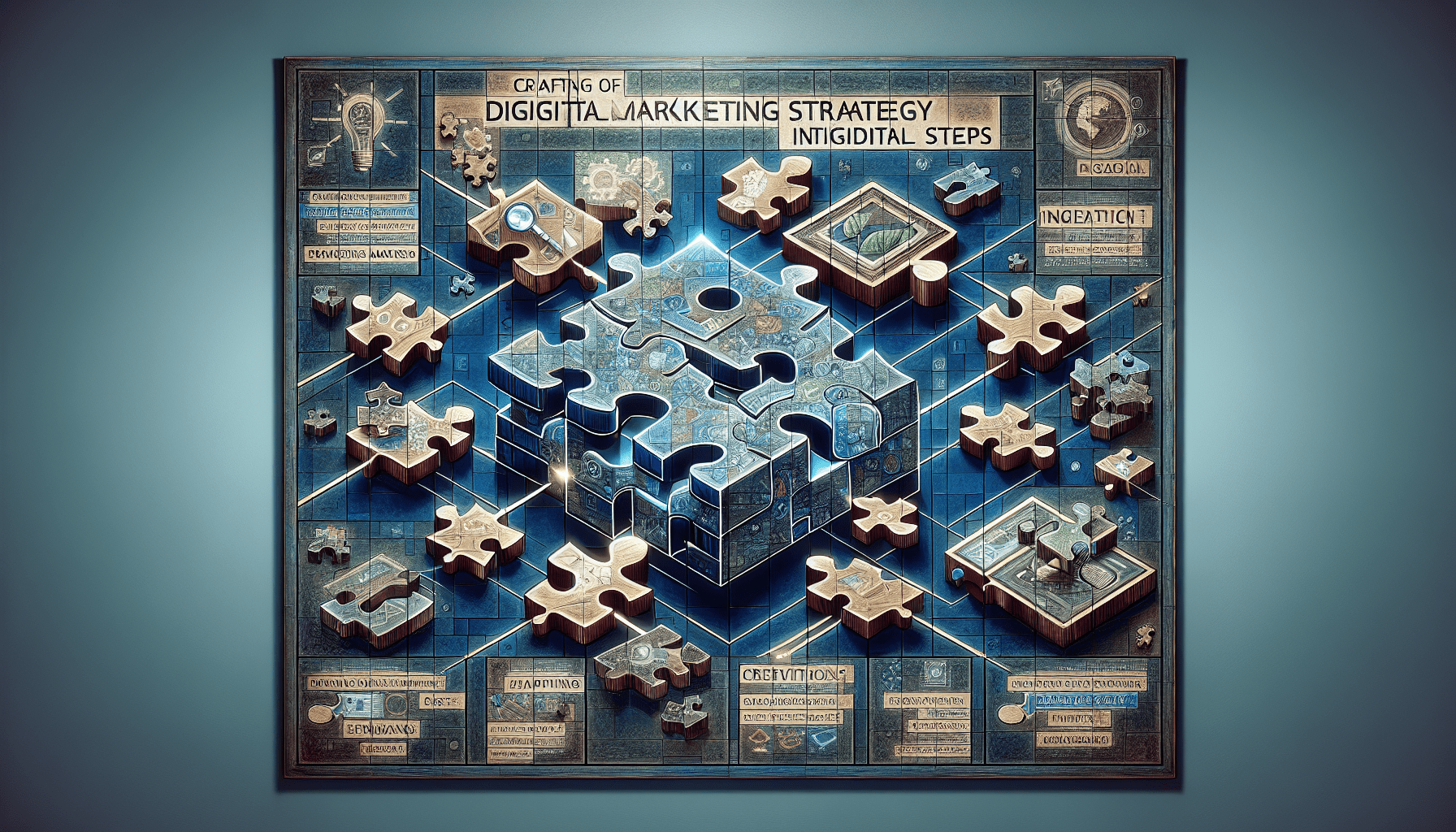
Crafting a digital marketing strategy can be a daunting task, but with these 10 essential steps, you will have a clear roadmap to success. From defining your target audience to choosing the right platforms, this article will guide you through the process of creating an effective digital marketing strategy that will help you reach your goals. Whether you’re a seasoned marketer or just starting out, these steps will provide you with the necessary tools and insights to navigate the ever-changing digital landscape. Get ready to take your online presence to the next level and connect with your audience in a meaningful way. Let’s dive in!

Understanding Your Business Objectives
When crafting a digital marketing strategy, it is crucial to first understand your business objectives. This involves identifying your business goals, understanding your product or service, and identifying your Unique Selling Proposition (USP).
Identifying your business goals is essential because it sets the direction for your digital marketing efforts. Whether your goal is to increase sales, generate leads, or build brand awareness, having a clear understanding of what you want to achieve will guide your strategy.
Understanding your product or service is also important as it helps you determine how to position it in the market. What are the unique features or benefits that set your product apart? How does it solve a problem for your target audience? Knowing the answers to these questions will help you create a compelling marketing message.
Identifying your Unique Selling Proposition (USP) is crucial for standing out in a competitive market. What makes your product or service different from your competitors? What value do you offer that others don’t? By clearly defining your USP, you can effectively communicate your unique benefits to your target audience.
Identifying Your Target Audience
Once you have a clear understanding of your business objectives, it’s time to identify your target audience. This involves analyzing their demographics, psychographics, online behavior, and buyer’s journey.
Demographics refer to the statistical data that describes your audience, such as age, gender, income, and location. This information helps you understand who your ideal customers are and allows you to tailor your marketing efforts accordingly.
Psychographics delve deeper into the psychological and behavioral aspects of your audience. It includes factors such as their interests, values, attitudes, and lifestyle. Understanding these aspects helps you create marketing messages that resonate with your target audience on a deeper level.
Analyzing your audience’s online behavior is essential in today’s digital world. How do they use the internet? What platforms do they prefer? What kind of content do they consume? By understanding their online behavior, you can choose the right digital marketing channels to reach and engage them effectively.
Understanding your audience’s buyer’s journey is crucial because it helps you map out the different stages they go through before making a purchase. By identifying these stages, you can create targeted marketing campaigns and content that addresses the specific needs and pain points of your audience at each stage.
Establishing KPIs (Key Performance Indicators)
Setting up Key Performance Indicators (KPIs) is essential for measuring the success of your digital marketing strategy. This involves defining measurable goals, setting up analytics, and monitoring performance regularly.
Defining measurable goals is important because it allows you to track the progress and success of your digital marketing efforts. Whether your goal is to increase website traffic, generate leads, or improve conversion rates, make sure your goals are specific, measurable, attainable, relevant, and time-bound (SMART).
Setting up analytics is crucial for tracking and measuring the performance of your digital marketing campaigns. Tools like Google Analytics can provide valuable insights into metrics such as website traffic, conversion rates, bounce rates, and more. By regularly analyzing this data, you can make informed decisions and optimize your strategy for better results.
Monitoring performance regularly is necessary to ensure that your digital marketing efforts are aligned with your goals. By regularly reviewing your KPIs and analytics, you can identify areas of improvement, make necessary adjustments, and stay on track to achieve your goals.
Creating Buyer Personas
Creating buyer personas is an important step in understanding your target audience and tailoring your marketing efforts to their needs. This involves understanding customer needs, identifying their pain points, and understanding their decision-making process.
Understanding customer needs involves identifying the problems or challenges that your target audience faces. What are they looking for in a product or service? By understanding their needs, you can create marketing messages that highlight how your product or service addresses those needs effectively.
Identifying their pain points is crucial because it allows you to empathize with your audience and provide solutions that alleviate their pain. What obstacles do they face in their daily lives? How can your product or service solve those problems? By addressing their pain points, you can position yourself as a valuable solution provider.
Understanding their decision-making process involves mapping out the steps your audience goes through before making a purchase. This includes researching, comparing options, and evaluating alternatives. By understanding this process, you can create content and marketing campaigns that guide your audience towards choosing your product or service.

Choosing The Right Digital Marketing Channels
With a clear understanding of your business objectives and target audience, it’s time to choose the right digital marketing channels to reach and engage your audience effectively. This includes utilizing SEO, email marketing, social media marketing, and content marketing.
SEO (Search Engine Optimization) is essential for improving your website’s visibility in search engine results. By optimizing your website for relevant keywords and providing high-quality content, you can attract organic traffic and improve your chances of ranking higher in search engine results.
Email marketing is a powerful tool for nurturing leads and staying connected with your audience. By creating targeted email campaigns and delivering valuable content directly to their inbox, you can build strong relationships and encourage repeat business.
Social media marketing is crucial for engaging with your target audience and building brand awareness. By choosing the right social media platforms and creating engaging content, you can interact with your audience, showcase your products or services, and keep them updated with your latest offerings.
Content marketing involves creating valuable and relevant content that attracts and engages your target audience. By providing informative blog posts, videos, infographics, and more, you can establish yourself as an expert in your industry and build trust with your audience.
Creating An Engaging Content Strategy
An engaging content strategy is key to attracting and retaining your target audience. This involves identifying effective content formats, creating a content calendar, and determining content promotion tactics.
Identifying effective content formats involves understanding the preferences of your target audience and delivering content in the formats they prefer. This can include blog posts, videos, podcasts, infographics, and more. By diversifying your content, you can cater to different learning styles and capture the attention of a wider audience.
Creating a content calendar is essential for staying organized and consistent with your content creation efforts. By planning ahead and scheduling your content, you can ensure a steady flow of valuable content that keeps your audience engaged and coming back for more.
Determining content promotion tactics involves identifying the channels and strategies you will use to distribute and promote your content. This can include social media promotion, email marketing, influencer outreach, and more. By effectively promoting your content, you can reach a wider audience and maximize its impact.
Optimizing For SEO
Optimizing your website for search engines is crucial for improving your online visibility and driving organic traffic. This involves understanding SEO basics, conducting keyword research, and implementing on-page and off-page SEO strategies.
Understanding SEO basics involves familiarizing yourself with best practices and techniques for optimizing your website. This can include optimizing your website’s structure, meta tags, URLs, and more. By following SEO guidelines, you can improve your chances of ranking higher in search engine results.
Keyword research is crucial for identifying the keywords and phrases that your target audience is using to search for products or services like yours. By incorporating these keywords naturally into your website content, you can increase your chances of appearing in relevant search results.
Implementing on-page and off-page SEO strategies involves optimizing both the content and structure of your website, as well as building high-quality backlinks from reputable sources. By optimizing your website and building a strong online presence, you can improve your website’s visibility and attract more organic traffic.
Implementing An Effective Social Media Strategy
Social media is a powerful tool for connecting with your target audience and building brand awareness. To implement an effective social media strategy, you need to choose the right social media platforms, create a posting schedule, and develop engagement strategies.
Choosing the right social media platforms involves identifying where your target audience spends their time online. By focusing your efforts on the platforms they frequent the most, you can maximize your reach and engagement.
Creating a posting schedule is essential for maintaining a consistent and engaging presence on social media. By planning and scheduling your posts in advance, you can ensure a steady flow of content that keeps your audience engaged and interested.
Developing engagement strategies involves actively interacting with your audience on social media. This can include responding to comments, answering questions, and initiating conversations. By engaging with your audience, you can build strong relationships and foster brand loyalty.
Setting Up a Conversion Path
A conversion path is the journey that a potential customer takes from the first interaction with your brand to making a purchase. To set up a conversion path, you need to create landing pages, set up call-to-action buttons, and define the path to purchase.
Creating landing pages involves designing web pages that are specifically tailored to convert visitors into leads or customers. By providing valuable offers or incentives and optimizing your landing pages for conversion, you can increase the chances of turning visitors into leads.
Setting up call-to-action buttons is essential for guiding your audience towards taking the desired action. Whether it’s signing up for a newsletter, downloading a free guide, or making a purchase, call-to-action buttons provide a clear direction and make it easy for your audience to take the next step.
Defining the path to purchase involves mapping out the customer journey and identifying the steps they need to take before making a purchase. By understanding the decision-making process of your audience, you can create targeted marketing campaigns and content that effectively guide them towards making a purchase.
Measuring and Adapting the Strategy
Measuring the performance of your digital marketing strategy is crucial for making informed decisions and optimizing your efforts. This involves tracking relevant metrics, analyzing results, and making changes based on insights.
Tracking metrics involves monitoring key performance indicators (KPIs) that are relevant to your business goals. This can include metrics such as website traffic, conversion rates, bounce rates, engagement rates, and more. By regularly tracking these metrics, you can gain valuable insights into the effectiveness of your digital marketing efforts.
Analyzing results involves interpreting the data collected from your tracking efforts and identifying patterns or trends. By analyzing the results, you can identify areas of improvement, uncover opportunities, and make data-driven decisions to optimize your strategy.
Making changes based on insights is an important step in continually improving your digital marketing strategy. By adapting your approach, experimenting with new ideas, and implementing changes based on insights, you can stay ahead of the competition and drive better results.
In conclusion, crafting a comprehensive digital marketing strategy requires a deep understanding of your business objectives, target audience, and the right channels and tactics to reach and engage them. By following the steps outlined in this article, you can create a solid foundation for a successful digital marketing strategy and achieve your business goals.


